Key Takeaways from Day Two of WasteExpo 2019
Here's a look at the panel sessions and key takeaways from day two of WasteExpo.

Day two at WasteExpo continued to bring in thoughtful insights from some of the biggest players in waste and recycling. Bill Caesar, CEO of WCA Waste Corporation, stepped in at the last minute to fill a vacant seat for the CEO Fireside Chat Spotlight Session, where he had a candid—and at times heartfelt—discussion with Darrell Smith, president and CEO of National Waste & Recycling Association (NWRA).
Advanced Disposal Systems (ADS) CEO Richard Burke was initially slated to speak during that session, but plans changed after Waste Management announced its acquisition of ADS last month.
When asked about his leadership style, Caesar told Smith there are a couple things that would describe his style.
“The first one is honesty,” he said. “I make a point of ensuring that everybody knows what I think is important, why I think it’s important and that I will always be straight with them. I will always be fair. I can’t claim that I will always be patient, but I will always be fair, and I will always be honest both to the people who work for me and for the people I work with.”
Caesar added that he typically manages by asking a lot of questions, not because he’s testing someone, but because he genuinely wants to know what and why something happened, what it means and what could possibly be learned from it.
“I don’t look back on much of anything,” he explained. “I may not be the most optimistic person, but I am definitely a forward-thinking person. I know how to move on from things that have happened. I don’t dwell on those things, but I do want us to learn from them, so we don’t make the same mistakes. How I interact with my people is extremely important to me.”

Smith then asked Caesar about WCA’s recycling business, as it’s been a hot topic amid China’s National Sword. Caesar noted that recycling accounts for roughly 1.8 percent of WCA’s revenue.
“It is not the most important thing that I do,” he said. “However, even at 1.8 percent, it has a meaningful impact on my ability to deliver the financial performance that my board is looking for. And compounding that, because of my prior position at Waste Management, I know way more about recycling than the average bear. Sometimes, you just have to say, 'look, we’re doing the best we can.' If there were a secret to recycling, we would have figured it out by now.”
“Improve operations and try like hell to get someone to buy the stuff you’re making,” added Caesar. “At the end of the day, run your plant as efficiently as possible, don’t pay for crappy material, and, if you can, sell everything that you have. At the end of the day, the vast majority of the value in which you create for recycling is a function of things that are completely out of your hands.”
Caesar also noted that WCA has ramped up its recruiting efforts and is working to bring more women and qualified workers into the industry. He added that the company also reaches out to commercial driving schools to begin introducing students to the industry.
Then, the topic of safety came up.
“I spent 13 years at McKinsey, I spent six years at the CIA and nobody ever died on my watch, and I can’t say that today. We had our first fatality of an employee about three weeks ago, and I still can’t sort it out yet,” said Caesar, holding back tears. “One piece of advice I have is to make sure that your employees know that their lives are worth more than any piece of equipment that you own and that they should never put themselves in a position where they could get hurt because a piece of equipment is going to get damaged.”
During a panel titled “CFO Insights: A Look at the Waste & Recycling Industry,” NWRA Women’s Council Member Allia Saydjari moderated a panel comprising Devina Rankin, CFO of Waste Management; Dianna Cervantes, CFO of WCA Waste Corporation; Mary Anne Whitney, senior vice president and CFO of Waste Connections; Ned Coletta, senior vice president, CFO and treasurer of Casella Waste Systems; and Chuck Serianni, executive vice president and CFO of Republic Services. In another candid discussion, the CFOs of the industry’s leading companies opened up about the overall health of the industry, sustainability and technology, as well as the fact that three of the five CFOs on the panel are women.
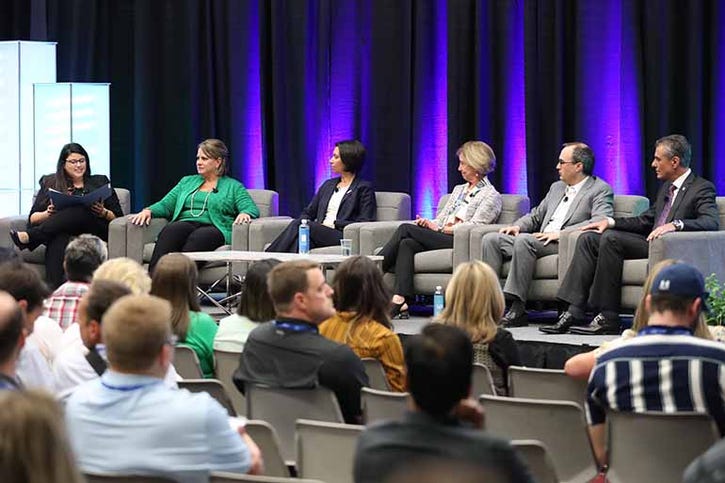
“This is the best shape that the industry has been in,” said Rankin. “I think the industry is in the best health that I have ever seen, and it’s really a great time to be in the business. There is a major focus on people, a focus on process and thinking about our responsibility as environmental stewards. Finance was once viewed as a function and the ‘keep-the-lights-on’ part of the business, but that has since changed. This industry is about people and relationships. In the past, I think we were hesitant to embrace change and innovation, and now I think we know we can do both.”
Regarding sustainability, Coletta noted that Casella Waste decided years ago that sustainability is not sustainable unless the economic model works. He added that it has been difficult to break through the “wishcycling” trend.
Rankin pointed out that over the last decade, Waste Management has worked to try to thwart aspirational recycling for its customers. “It doesn’t happen easily, it takes a lot of work and a lot of research,” she said.
Serianni echoed both sentiments, adding that Republic Services has been reaching out to residents to make sure they know what items can and cannot go into their recycling bins. The company launched its recyclingsimplified.com site to help customers become more responsible recyclers.
When discussing the growing industrywide labor shortage, Waste Connections’ Whitney noted that the federal government needs to develop an immigration policy that could ease some of the industry’s labor burden.
“We’re a safer industry than we were 20 years ago, and we are a less demanding industry with automation,” she explained. “At the end of the day, it’s a labor availability issue, not a wage issue. We have a culture where people want to stay. Once you get people for a year, you’ve got them for life. Once people get into this industry, they realize what a great business this is and what a resilient industry it is when the economy turns. I think we are all trying to do the best we can.”
After the panel concluded, Waste360 Senior Editor Cristina Commendatore spoke with Rankin about some of the key insights from the panel, as well as some further details about Waste Management's acquisition of Advanced Disposal.
In a session called “Organic Waste Bans, Mandatory Organics Recycling Laws, and Related Strategies for Food Waste Management,” Katie Sandson of Harvard’s Food Law and Policy Clinic Center for Health Law and Policy Innovation and Lorenzo Macaluso with the Center for EcoTechnology (CET) dove into what’s going on with the five states with food waste bans. They talked of a flurry of legislative activity suggesting more local governments may adopt similar policies. And they shed light on what’s entailed in setting up infrastructure to make a ban work.
The states that have some form of a food waste ban are California, Connecticut, Massachusetts, Rhode Island and Vermont—and in 2022, New York will adopt a policy that includes a ban for some businesses. In the most recent legislative session, another 30 states had bills addressing food waste “so it’s on state policymakers’ minds,” Sandson told a captive crowd.
There are issues around developing infrastructure. And bans often present a chicken-and-egg scenario; no one wants to build capacity without guaranteed feedstock, but governments hesitate to take the policy plunge without knowing the waste will have a place to go.
The Food Law and Policy Clinic is releasing a toolkit in the next few weeks to help with some of the challenges, incorporating some ideas that came from speaking to states that have taken the lead.
One reality that became clear to Sandson and her colleagues is as new policy evolves, permitting requires more thought.
“Rhode Island revised its original permit regulations. It developed a permit structure with a tier system based on throughput. Those at the lower end of the tier have the least amount of obligations and risk. The more food waste, the stricter the permit regulations,” she said.
There can be back-and-forth conversations over multiple issues, as she pointed out New York, whose ban just passed late April.
“It’s been a long process,” she explained. “Among issues they needed to work out is a distance exemption [whereby generators beyond a certain distance from a processor do not have to participate.]”

Ideally there would be limited distance between generators and processors because this can help get buy in from haulers and generators who would otherwise have burdens imposed by long trips.
The downside, said Macaluso, is some large facilities just outside the radius could otherwise help with diversion goals.
New York originally proposed a 50-mile distance exemption, which was lowered to 25 miles. Later came a proposal for a more robust waiver for generators with hardship. The final ban exempts schools and most of the healthcare sector.
New requirements, whatever they be, are typically phased in over time.
New York City, which adopted its own ban ahead of the state, did a capacity analysis and based on its findings will phase in additional covered generators. Phase one will include a new set of categories requiring more businesses to comply, but Sandson said there’s been pushback.
Vermont’s phasing in requirements over time, and there’s been protest there, too.
“All haulers in Vermont are scheduled to have to offer services, but many of them said they don’t have money to upgrade. There’s been a lot of back and forth, with the date pushed back more than once. And there is a recommendation on the table to eliminate the requirement,” said Sandson.
As governments figure out how to manage waste they will no longer allow on landfills, the U.S. Environmental Protection Agency’s (EPA) whole food waste reduction hierarchy is being aggressively pursued, said Macaluso.
There’s been innovation to reach for the tiers higher up on the hierarchy, including creative transportation solutions and many technology solutions for food waste prevention.
Policies can be designed to help move the needle in implementing a ban or in just setting up a robust food waste reduction plan, with or without a ban. Some states and local governments have funding mechanisms. Connecticut and Massachusetts have supported anaerobic digestion (AD) projects and other means to build food waste management capacity. CalRecyle in California also offers grants for infrastructure development.
Beyond these commitments, public-private partnerships can be key, namely for siting AD or compost facilities. And Vermont has developed policy to incentivize diversion through a pay-as-you-throw (PAYT) policy, a model where customers pay for waste services by volume, weight or cart size. It’s structured so they pay a higher rate for disposing more waste and less for recycling and composting.
All Vermont municipalities comply with PAYT, and many of them reported they’ve seen reduced trash collection costs and more recycling and composting, said Sandson.
Key to establishing a ban or any far-reaching food waste reduction plan, she told session attendees, “is to have stakeholder engagement through the process and to begin engagement early.”
CET has worked on food waste for 20 years, supporting states, commercial generators and composters.
In helping Massachusetts, we were able to see the primary components that are most important to setting up viable strategies [to support a ban or food waste reduction plan]. Those components are infrastructure development, policy, education and technical assistance. When all these components work together is when we see the fastest growth,” said Macaluso.
“NOTHING WASTED!: Industry Visionaries Discuss Solutions to Food Waste & Wasted Food” drew a throng of engaged attendees. They listened to Darby Hoover of the Natural Resources Defense Council, Stephen Hamilton of California Polytechnic State University and Jonathan Deutsch of Drexel University discuss consumer confusion about dealing with waste and ideas for bringing clarity. A captive audience learned of interesting research findings about human habits. And they heard an equally intriguing story about how a lot of bananas that would have ended up in landfill became a sweet surprise for hungry families—as well as the bigger picture behind this story.
About 80 percent of food waste is generated by consumers and consumer-facing businesses. That’s why this session focused on individuals as generators. Hoover began by saying confusing language and judgmental messages drive up this consumer garbage problem.
“We know putting waste in a hole in the ground is not a good way to manage it,” said Hoover. “So, we created a diversion concept as an alternative to disposal but did not clearly define disposal. We put out trash bins and recycle bins, and we decided to maximize this ‘diversion’ concept by telling people the ‘good’ way was to put everything in the bin.”
But then the conversation usually stops. There’s rarely talk about what does or does not happen to diverted materials beyond simply that they are not disposed.
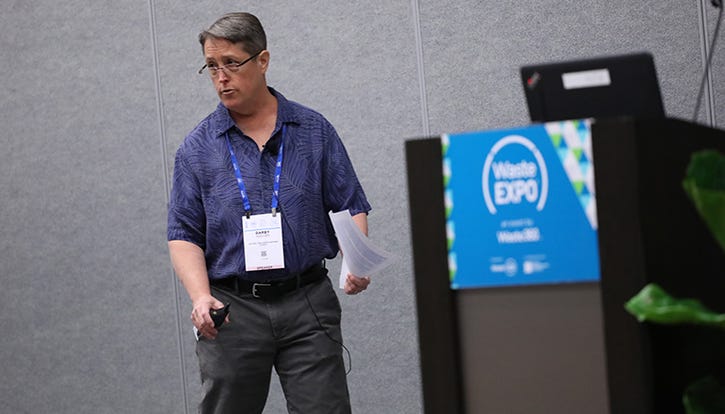
“We should point to what we want to happen, not just what we don’t want to happen,” she said.
There is the same confusion around food waste she told attendees, pointing out there is no universal definition for food loss or food waste. Recycling’s benefit is it gets materials in production, and the same needs to happen with food scraps, Hoover contended.
“We need to talk, not just about keeping scraps out of landfills but about using them. We need to look at viewing scraps as a resource, and collect, process and manufacture them to render them useful,” she challenged.
Hamilton worked on studies on food loss funded by the U.S. Department of Agriculture, including those focused on waste at retail and household levels. He and the research team concluded that food waste is a product of what he called utilization, which makes it easy to use food. He cited having ample refrigerator space as an example, which at the very least he said may not help prevent food waste. If you make it easier to use food, people may actually buy more and sometimes waste more, he said.
Hamilton suggested taxing household food waste is likely the best way to reduce it. But the study found different households respond differently.
“Trying to account for waste is what’s needed. We need to go to prices per pound. When you price waste and it’s costly, people might be more careful about throwing it away or [they may make other changes],” he said.
He brought up the concept of deposit refunds that charge high prices and then return subsidies.
“It’s a tax on waste up front and a rebate after food waste goes where you want. That rebate can go into compost programs that may need to be subsidized. I think this is where the market has to go to try and solve the problem,” he said.
Deutsch talked about getting culinary experts to help see that good food serves a purpose. He spoke of food scientists who make unhealthy food "cravable." and he asked, what if we could apply the same technologies to work with healthier, more sustainable food?
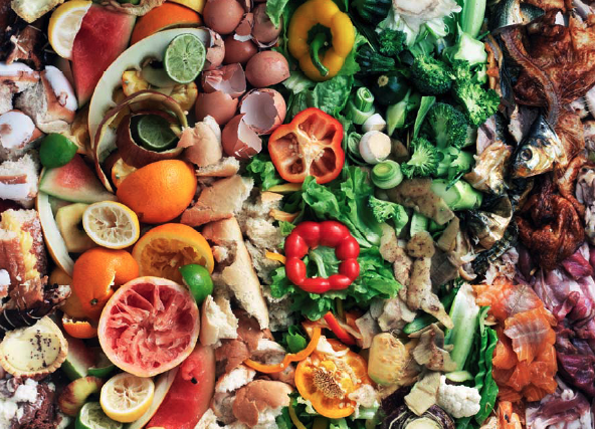
Policy Strategies for Managing Food Waste
He and Drexel students became involved in a Philadelphia pilot to see that nutritious surplus food got to people in need rather than to landfill. During this project, a local food bank picked up donations from a grocery store and distributed them. But certain produce was problematic; these perishables needed to be moved fast. So, the grocer typically sent them to compost.
A lot of bananas ended up getting tossed in a dumpster after students' first effort to dole them out. With the next shipment, students made banana ice cream. It didn’t call for a lot of ingredients, and leftovers could be mashed and frozen. Not to mention every shelter resident must have milk and a snack each day; and ice cream, even with healthy fruit, went over well.
While this one project may not move the needle, through their concept, students transformed mechanics of a problem [moving perishable food for consumption] into a solution and for people who rarely eat healthy, Deutsch pointed out.
Drexel’s next steps are to help food upcyclers with technical assistance to take food recovery and use further. Deutch also is working on a culinary curriculum to increase instructors’ awareness of how this niche can further support food rescue.
In “Current Business Trends Shaping the Industry: What You Need to Know,” Leone Young of LTY ERC, Daniel Butturini and Richard Sterner of Sterner Consulting and James Thompson with the Waste Business Journal discussed how the waste management industry is doing financially today and what they foresee moving forward.
Industry stakeholders were not worried about the slowing economy this past December. Eventually another slowdown is inevitable, but there is likely no reason for major concern when that day comes either, believes Young, who commented, “We think the industry will be more resilient.”
Landfills are filling up, which is an especially acute situation in the Northeast. And because recycling has slowed, more is going for disposal.
“We will have a better handle on [the landfill capacity situation] in six months to a year. But now it’s a bit much to say we are looking at a nationwide capacity crunch. Though landfill pricing is heading up,” Young told attendees.

China is tightening standards again. It appears it is serious about a 2020 solid waste ban. New mills are supposed to open and use recycled fiber, but they have been delayed. As a result, and with slow box demand, we have a bloated fiber market that is driving down prices, she said.
Her long-term projection is more optimistic. Mills are coming online that will take more recycled material, and with cheap feedstock, more will be invested. She noted while recycling is down for now, it is not out.
Materials recovery facilities (MRF) are investing in technology to get cleaner streams. And 37 major brands instituted major recycling pledges.
“We have heard [similar positive comments] in the past, but pressure is more intense now, and we hope more recycled content will lead to more market demand,” she said.
Waste management is a $74 billion industry, where 20 years ago it was worth $41 billion. Many municipalities are getting out of the businesses, and publicly-traded companies are increasingly dominating, Thompson pointed out.
Waste Management commands most of the share—25 percent of landfill volumes—followed by Republic Services and then Waste Connections. If Waste Management’s acquisition of Advanced Disposal becomes official, it will become larger yet—controlling 33 or 34 percent, “and that will be dramatic,” Thompson said.
The waste-to-energy niche is rising very slowly in the U.S., but no new plants have been built in decades other than one in Florida in 2015. “It’s increasingly harder to build new ones, which is bad for long-term capacity,” he said.
But another niche is seeing growth: construction and demolition (C&D). About 126 million tons of C&D waste are generated a year and an estimated 30 percent is recovered. C&D tip fees are increasing, which helps encourage recycling, Thompson explained.
Butturini commented that in the last two or three years, acquisitions have played an increasing role in industry growth, with small companies bought up by the majors. He discussed factors that affect valuation of transfer stations, hauling companies, MRFs and landfills, pointing out considerations like the ability to get long-term “evergreen” contracts and permit capacity. And in the case of specific types of services for landfills, host community agreements and post-closure costs were factors. For transfers stations, transfer and disposal costs were especially relevant.

Butturini focused especially on recycling, sharing his thoughts on its fate. “Players on the edge of the market will disappear, and the recycling business will be left to a few really good operators spending on new processing and equipment who will push back on suppliers of commodities and who will demand better quality from generators.”
“We’ve been riding up and down this cycle for at least 20 years,” he added, commenting he does not believe the ride can go on indefinitely. “For those who stay in business, I think the long term will be better and with bigger business.”
At “Technology Innovations and other Solutions to the Problem of Wasted Food,” Coryanne Mansell with the Center for EcoTechnology (CET) and Michael Corbett of Divert touched on food waste-derived biogas energy potential and other ideas and technologies to make the most of this organic resource. Lorenzo Macaluso of CET moderated.
A mere 1 to 4 percent of energy is recovered from food waste to make electric power; 4 to 11 percent of thermal energy is recovered from conversion technology, according to Corbett.
“If you are serious about climate change, you would say we are spending all this energy to make food and ask, 'am I happy about getting about 10 percent or less out?'" he said. “Does energy from food waste make sense? It does, but that should be the last thing we do when we can’t do anything else with it.”
Admittedly, organics need to go somewhere other than landfill, especially in states where tip fees are astronomical. Landfill costs in Massachusetts are about $85 per ton. And there’s a lot more that can be done where communities would be better off and make a little bit of energy, but the energy is a small part, Corbett asserted.
Divert does rely on recovery technologies in its work to help retail chains recycle efficiently, such as data analysis and automated monitoring. The company developed a system where stores put radiofrequency identification (RFID) on bales of cardboard, and distribution centers outfitted with RFID tag readers can track materials through these business’ process.
“This is to track what is diverted upstream and to be proactive if, for instance, the number of bales that should be recovered isn’t. The same analytics can be used on organics to better understand the flow of the waste stream and make improvements,” he explained.
CET supports businesses in using technologies that address all tiers on the EPA’s food waste recovery hierarchy. For instance, businesses are reducing food waste applications like LeanPath and Phood that enable generators to track food waste and generate reports. Phood is working with CET, the state of Rhode Island and several Rhode Island universities to pilot a source reduction program.
![]()
“These technologies can be entry points to other food waste diversion strategies,” said Mansell.
She pointed out that after Rhode Island University began using the technology, it started looking closer at its waste streams and evaluated other opportunities.
“They saw that on Mondays and Thursdays, they always had egg surplus and were able to reevaluate menus to prepare less. Through combined efforts, the pilot program of seven university sites reduced 27 tons of food waste from their cafeterias in one semester,” said Mansell.
She thinks software applications will pave the way for more businesses to better understand and be proactive about managing food waste as well as encourage donations as some of them provide a platform to match donors with surplus food with organizations that distribute it to hungry people.
Apps like MEANS Database and Food Rescue U.S. perform these functions. MEANS connects food pantries and soup kitchens with nearby businesses with surplus items in real time, enabling food to move fast. Food Rescue U.S. provides a platform enabling volunteers to deliver edible surplus items.
De-packaging is one of the newer technologies used to address wasted food, and through the process, operators are reaching higher hanging fruit that’s harder to recover. While technologies vary, packaged items can go into processing machines; food waste is extracted and sent to anaerobic digesters while the packaging can be recycled.
“The food donation apps make volunteering more accessible as people have more flexibility in scheduling their time. And, in general, they make the process to donate edible food and reduce waste easier. And resources like de-packaging facilities help provide ease for source separation,” said Mansell.
There has been tremendous innovation in technology solutions at all levels of hierarchy, from preventing to recovering and processing, Macaluso summed up.
“From CET’s perspective, part of our job is be a matchmaker,” explained Macaluso. “And all these solutions are very helpful in finding the strategy that works best for each business.”
Day two also included the annual NWRA Awards Breakfast, where Driver of the Year, Operator of the Year, Hall of Fame, Distinguished Service, Member of the Year and the Chapter Leadership Award winners were recognized for their contributions to the waste and recycling industry.
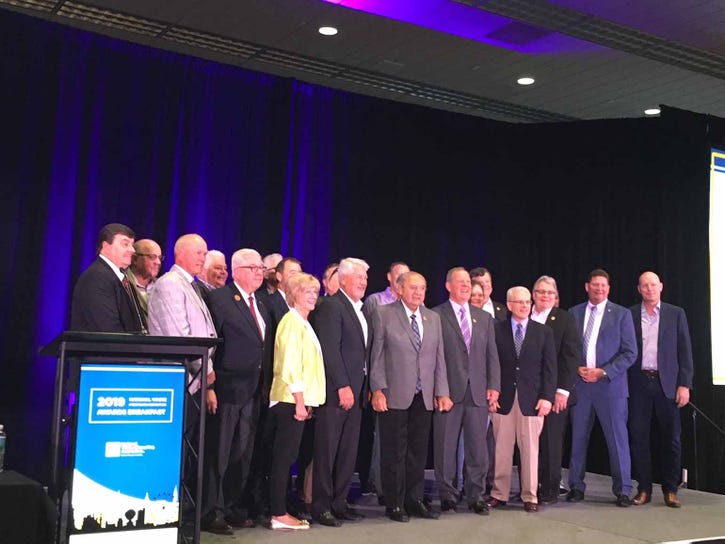
The fourth annual Waste360 40 Under 40 awards ceremony also was held on day two. The awards honor the next generation of leaders who are shaping the future of the waste and recycling industry.
"The future is bright! The 2019 class of Waste36040 Under 40 awards winners is filled with today's brightest young innovators, thinkers and doers in the waste and recycling industry,” says Waste360 Vice President Mark Hickey. “Their diverse body of work has changed processes, policies and moved our industry forward."
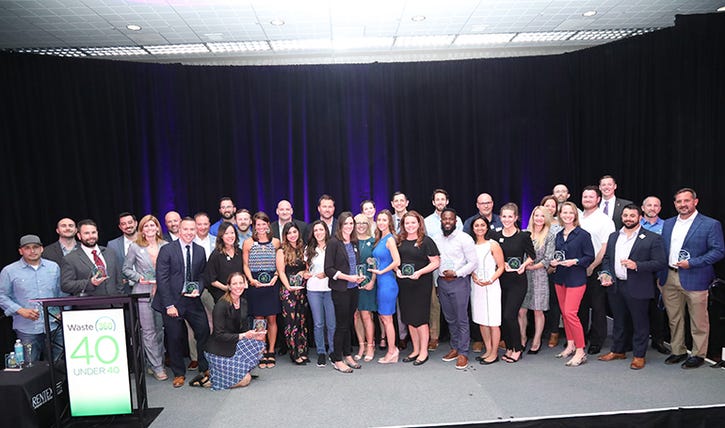
New to the awards this year was the Waste360 Innovator Award, which was created to recognize innovators and forward thinkers who often use technology to better the industry. This award was presented to Dr. Matanya Benasher Horowitz, chief executive officer of AMP Robotics Corporation, who has used technology to help haulers, landfill operators and materials recovery facility operators reach their diversion and recovery goals.
After the awards ceremony, Waste360 Editorial Director Mallory Szczepanski went live on Facebook with Horowitz to talk about his accomplishments and what the future has in store for technology and AMP Robotics.
Day two of WasteExpo once again included the Zero Waste Lunch, where a grouping of attendees and speakers enjoyed a meal made from food that would otherwise go to waste. The lunch, which took place inside a cleaned-out dumpster, consisted of a spring rainbow carrot salad made from rocket lettuce, rainbow carrot peels, celery sprigs, fried shallot ends and a honey carrot puree vinaigrette; a kabob surf and turf made from grilled beef trimmings with chimichurri and grilled lemon, garlic samon belly kabob with basmati rice and vegetable medley succotash; and a white chocolate blueberry bread pudding topped with sweet cream and crème anglaise.
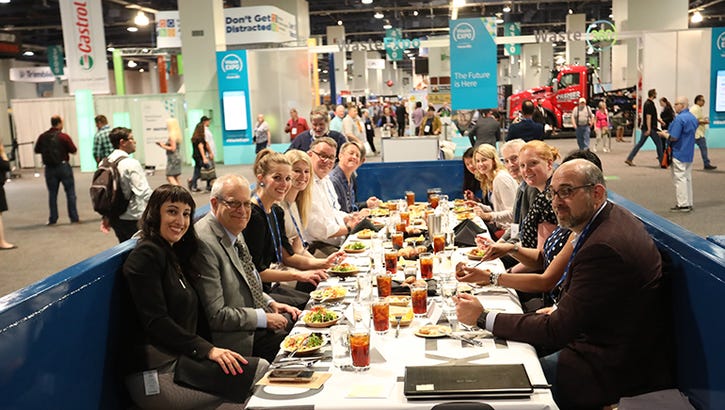
About the Authors
You May Also Like







.png?width=300&auto=webp&quality=80&disable=upscale)